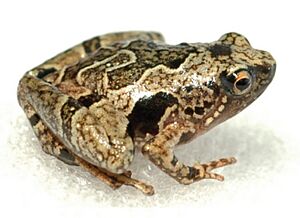Nanohyla petrigena facts for kids
Quick facts for kids Nanohyla petrigena |
|
|---|---|
 |
|
| Conservation status | |
| Scientific classification | |
| Synonyms | |
|
Nanohyla petrigena is a tiny frog that belongs to the Microhylidae family. You can find this special frog in parts of Borneo, including Brunei, Malaysia, and Indonesia. It also lives in the Sulu Archipelago in the Philippines. People sometimes call it the pothole narrow-mouthed frog or the Kapit rice frog.
Contents
What's in a Name?
This frog's scientific name has changed over time. It used to be in a group called Microhyla. But in 2021, scientists studied its body features and DNA. They found that Nanohyla petrigena and eight other frog species were different enough. So, they created a new group, or genus, called Nanohyla just for them.
How to Spot This Frog
Nanohyla petrigena is a very small frog. Adult males are about 14–16 mm (0.6–0.6 in) long. Females are a bit bigger, around 15–18 mm (0.6–0.7 in) long. That's about the size of your thumbnail!
This frog has only three fingers on each hand. Its back is usually brown. It has dark marks on its shoulders. There is also a light stripe on its side. The frog's belly is dark with a white blotch.
Frog Calls
Male Nanohyla petrigena frogs make a special call to attract mates. It sounds like a single, short pulse. They repeat this sound in a series. A series can have up to 15 notes. They call about 0.7 times per second. The calling rate slows down near the end of a series.
Where It Lives and How It Breeds
Nanohyla petrigena lives in lowland rainforests. These forests are usually below 700 m (2,300 ft) in height. The frogs like to hide in the leaves on the forest floor.
They breed in small puddles. These puddles are often found in rocky areas near clear streams and rivers. Breeding seems to happen only on certain nights. The frog eggs float together in a mass on the water's surface. The young tadpoles swim and feed in the middle of these pools.
Protecting the Pothole Frog
This frog needs its natural home to survive. It cannot easily live in places changed by humans. Its home is threatened by habitat loss. This happens when forests are cut down. Trees are often removed for wood or to make space for palm oil farms. The place where this frog was first discovered has already been destroyed. The frogs likely no longer live there.
However, Nanohyla petrigena does live in some protected areas. These areas help keep its forest home safe. Protecting these places is important for the frog's future.


